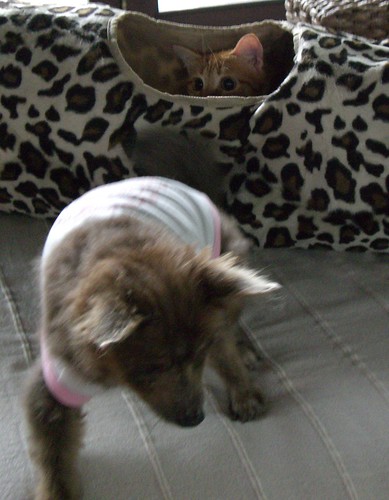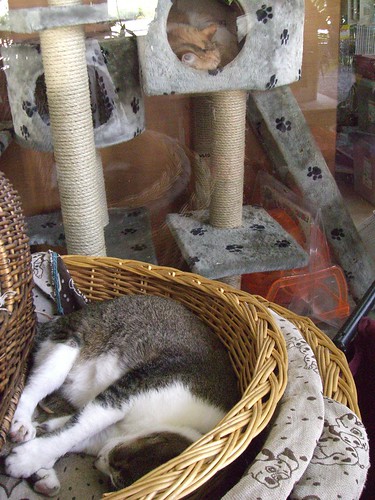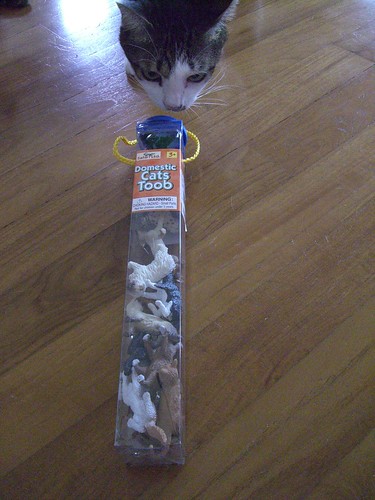Wednesday, April 30, 2008
Biodiversity Talks
There are a bunch of biodiversity talks at the Botanics over the next month. They look really interesting so here's the information. We are lucky to live in a part of the world with amazing biodiversity.
ST (30-4-08)
What I find interesting is that while I agree that the artificial line that TCs draw often seems rather arbitrary, the fact is that the rat is in the house. The people who are going to be most affected are not the TC officers - but the family itself. It's surprising to me that there seems to be almost an abdication of responsibility in this letter - and that the family is waiting for the TC to get rid of the rat for them.
When I am away in the US, there is a serious rat problem in the city where I live. There are rats running around the street as large as cats. I've been told they have killed kittens (and they bite through plastic garbage cans). There is no official to come and fix the problem for you. Almost everyone I asked has a mouse, or rat, problem - they run up the walls of apartment blocks into homes. When we had mice, we just spent a lot of time trying to find the source of the problem (mice will come in as long as there is a tiny hole, especially when it's cold) and blocked up the entry holes. The problem stopped. Interestingly, the problem actually started when a neighbour with a cat moved out above - during the years she lived there, there wasn't a problem at all as the mice never ventured in.
I do however agree with the letter writer that it's best to nip the problem in the bud, and to solve the issue at the root cause. Maybe they ought to encourage community cats in the area and that will help to cut the rat population down.
Tuesday, April 29, 2008
Dogs help prevent allergies
Monday, April 28, 2008
Cats sleeping
I was out this afternoon and saw these two cats asleep - is there anything better to do than nap on a scorching hot day?
The Bible on Animals
Sunday, April 27, 2008
Save the Sharks
Saturday, April 26, 2008
ST (26-4-08)
Friday, April 25, 2008
Meep and River
After a difficult week of dog versus cat issues (which I still maintain is a false distinction - it's really about animal issues and not factionalism), I thought this would be a nice photo.
Thursday, April 24, 2008
Now the cats are at risk too
I can understand the cat caregivers wrote in because they felt if the dogs are removed, that their cats will be safe. However as any caregiver knows, removal where the animal ends up in the AVA means death. Having seen that, a dog caregiver may well feel the same way - if the cats are removed too (and killed of course), then the dogs won't be in danger either because there won't be complaints against them.
It's a vicious cycle - and the only victims are the animals, both cats and dogs.
Wednesday, April 23, 2008
ST (23-4-08)
Stray dogs rarely attack, or even approach, humans
Pope and the cats
Pope shows softer side with love for felines
Tuesday, April 22, 2008
Moral Authority
I also don't happen to think it's about dogs versus cats - it's because the whole issue is about something larger, which is one of whether animals have a right to live in a society such as ours.
The difference I think also boils down to one of moral authority. The minute someone asks that an animal be killed in some circumstances, opens up ALL animals, cats, dogs, birds, monkeys etc, to the same fate.
Here's why - when you say that it is okay to kill in some circumstances (ie dog attacks, dogs being aggressive, the human population being put at risk) then should the same accusation be leveled at cats, then you are implicitly saying that you agree with the cats being killed as well. Do cats attack? Could cats ever conceivably be aggressive and attack? Yes if threatened or if the circumstances are such. During SARS, they were clearly accused of being a health risk.
If the thinking is that killing is okay under some circumstances, then you are saying that it is acceptable to kill the cats too. If you have asked for a dog to be killed/removed, then should your community cat be placed in a similar position of some complainant asking for it to be taken away for any of the reasons alleged, then you're going to have no moral authority to ask that the cats be spared. The same arguments that you have marshaled in asking for the dogs to be removed can be turned around and used to convict the very cats you are trying to save. The TC is just going to say to you, but the cats are a threat, just like the dogs - and if there is a child that got scratched for getting too close, you're going to have a hard time convincing the TC or the parents that your cat is not 'aggressive' and hence should be killed.
If people point to an increasing number of dog attacks/more dogs around, then I'll also point out that last year at CWS, I had the most number of 'cats attacking' complaints as well in my 6 years with them. One reason could well be that people don't quite know how to behave around the cats (and misread the behaviour), others that the cats are in situations where they for example are defending their kittens or themselves. One cat was just extremely territorial - and would attack people, dogs and even other cats. Maybe it's just that there are more instances where cats are coming into contact with people. The fortunate thing for these cats is that someone was there to look out for them, and they were given a reprieve.
Yes, we all know that unsterilised cats are caught and rounded up and killed. The question is do we agree with it? I don't believe any caregiver condones it - we know it happens, and we know that until the day every community cat has a caregiver, the killing is going to continue. We don't however actively support it or ask that it be done. (Thankfully with more caregivers, and more sterilisation, the number of cats killed last year I've heard anecdotally, dropped).
Would caregivers see a group of unsterilised cats and then ask for them to be killed? I doubt it. Surely you might point to the fact that cats are not posing a threat to other community cats. So what happens to the cat that does? I knew of a feeder last year who had a tom she couldn't trap and it was hurting very badly her community cats. I believed I blogged about the fact that she wanted to poison the tom cat. Would other cats that attack cats within the community also be weeded out and killed then?
Once we call for the killing of some animals (and obviously I'm not referring to euthanasia in the true sense of the term) then the floodgates are opened to the fact that all animals are then fair game. It's very hard to make a case that some animals should be spared if the circumstances really aren't that different.
On a side note, it seems that in the Jurong case at least, when I was speaking with one of the caregivers, that there is a dog feeder in the area. This may be why the dogs are in the area, and think it is their territory too.
Monday, April 21, 2008
Umbrella Part II
I would imagine the watergun/super soaker will also be quite effective - after all Scarecrows also work on cats, and I would imagine a concentrated blast of water will prove quite useful.
Umbrellas
Saturday, April 19, 2008
TNP (19-4-08)
While again I understand that people are more concerned about dogs running around loose, as opposed to cats, we do have people who use the same arguments about cats. I'm sure we've heard them all, ie cats might attack (and yes they may - if provoked into defending themselves), that cats are a nuisance/danger and should be removed and placed somewhere else. Dogs are obviously larger and are viewed as more of a physical threat than cats (though hearing some of the complaints I used to - and still - hear about cats you wouldn't think so). Again I do sympathise with the caregivers - having their cats killed can only be extremely painful. I can understand that they are at their wits' end and unsure of what to do to stop their cats be killed. I also know there's no easy solution, but to say that the dogs should be removed and not killed is akin to complainants saying they just want the cats taken away by the AVA and not killed, or hopefully adopted out. It's just not going to happen.
So what is the solution? Again, I am not an expert about dogs - but here are two things Ricky from ASD mentioned. One, food attracts the dogs - they are hungry and want to eat. If they know there is food being left in an area, then they move in. This may be why they are attracted to areas where cats are being fed. So ensure the area is clean afterward and food isn't left around (though this is easier said than done especially if you have irresponsible feeders around). Two, if the territory is perceived to be unfriendly, they, like cats, will move away. One thing to do is to use the supersoaker, pots and pans method to try and drive them away. With a lot of noise, and being 'shot at' by a watergun which is uncomfortable but which doesn't hurt them, they'll learn the area is not friendly and will avoid it.
One other thing to remember is that as more and more land in Singapore is developed, the areas where the dogs COULD comfortably live without coming into contact with people is shrinking. It's similar to the macaques who are finding themselves confronted by infringement in areas which were previously their homes and which were 'safe'. With more and more tracts being developed, this is probably only going to get worse.
Friday, April 18, 2008
ST (17-4-08)
While I really do sympathise with the caregivers who are losing cats, I fear it may go down a dangerous slippery slope. If people start complaining that cats are killing birds next, then are they the next ones to get rounded up and killed? During SARS, that was the argument used - that cat might cause disease (which could harm people - an even more untenable position for the cats) and hence this was the rationale behind rounding up and killing them.
There are no easy answers to this - when I spoke to Action for Singapore Dogs about attacks they suggested trying to break up the pack by scaring the pack leader off. When the alpha male runs, the rest of the pack will disintergrate The only successful case that I know of when the dogs didn't come back was when a group of caregivers stood guard at night - when the dogs approached, they went down with waterguns and pots and pans and make such a racket that the dogs were scared of.
I do realise it is a difficult decision for the caregivers though and they must be desperate after seeing their cats killed. It's a no-win situation.
Thursday, April 17, 2008
No NRIC number?
I spoke with the direct neighbour of the man whom the Scarecrow was loaned to (and the Scarecrow is still with him). She went to the police and apparently there was a Magistrate's order given for the two parties to go for Mediation in December, which she wants to do. Unfortunately, they did not have the identity card numbers for the two parties, and the case was referred to the police. She said that the police have said they are unable to get the numbers of the parties involved for some reason. The Magistrate told her it should take thirty days and it's been four and a half months. Since then one more of her cats was caught and has been returned. I advised her to seek help from someone higher up than the officer in charge of her case because it does seem very odd it should take so long to get details like your NRIC number.
Wednesday, April 16, 2008
I'm moving, help!
The problem is that she now has dozens of cats and she doesn't know what to do with them. She called up to ask what to do.
I asked her where the cats came from. Some have medical conditions, others she picked up during SARS, and yet others she picked up because people abandoned them. She complained that people kept throwing cats out despite her picking the kittens up and bringing them home. She wanted to call and ask if there were caregivers who would take her cats into their colonies.
I told her that it is highly unlikely anyone can absorb her 'excess' cats so to speak. Most people are struggling, and even an increase of two or three cats will be very difficult for the caregivers. In addition, no one in her area really is a caregiver - she knows one other feeder who had never contacted the TC because the feeder says the officers keep changing and she does not know whom they are.
It's a difficult situation, and abandonment is an on-going problem. The problem also is that removing the abandoned cats doesn't help - because the people dumping very often keep the unsterilised parents and those cats continue to breed. In the end, people end up taking in too many. Unfortunately some like this woman run into unexpected situations like having to move and that makes it worse.
Tuesday, April 15, 2008
Why do people feed?
This man not unexpectedly, told me that there were two feeders near his home. He said that they left a trail of food after 10 pm and asked if feeding was illegal. It seems they don't pick up afterward.
The interesting thing is that this man asked why people feed? I told him at the time that some people feed because they're compassionate, some may feed because they're lonely and enjoy the cats' companionship. He seemed satisfied with my abbreviated answer, but as I went home, I thought more about it and realised that there are so many more reasons why people do feed - probably every one has a different reason. Some people feed for merit, some because they came across some cats one day and felt sorry for them. Some people have started and can't stop now because the cats depend on them.
I think feeding hungry cats just hits a nerve somewhere deep down and makes most people want to alleviate the hunger - of course some critics will say that there are hungry people out there too, but you don't often see them wandering the streets. Here's the thing - I bet if most feeders saw a hungry person on the street, they would help feed the person too if they could.
On the other hand, feeding on its own, just to alleviate hunger doesn't solve the wider and bigger problem - that of reproduction. It doesn't solve the problem of complaints - and that's where TNRM has to come in. The minute the cats have better nutrition, the more likely they are to breed more often and have more kittens - and that leads to complaints. Feeding is a huge and really important component of TNRM - but it cannot be the only component or the cats are more likely to be in danger than ever before. That's something all the food in the world is not going to help with.
Monday, April 14, 2008
An Engineer's Guide to Cats
This is one of the funniest things I've seen in a long time from youtube user klusmanp. It's a little long but worth it to watch all the way to the end.
Friday, April 11, 2008
Kopi Luwak
Thursday, April 10, 2008
Orphaned Kittens
Wednesday, April 9, 2008
Mother cat and kittens
I saw this mother cat and her kittens yesterday as I was out with a friend. As you can see they are just a few days old and extremely tiny - without their mother they'll almost certainly not survive.
My friend who was with me made an interesting comment though. She has a cat but isn't a caregiver and she said to me that she hardly sees any pregnant cats around these days because they're mostly sterilised.
Tuesday, April 8, 2008
Emotional Blackmail
The caregiver is worried as she does not want to jeopardise her working relationship with the TC so doesn't want to bring this up higher. While I totally agree with her that working with the TC is the most ideal situation, one of the things to bear in mind is this - what happens when the TC won't work with you?
If someone holds something that you value dearly as ransom to make you do something you don't want to do, then it's termed emotional blackmail. That's what is happening here - the TC knows that the caregivers are worried about the cats. They also know that the complainants on the other hand have nothing to lose. So whom do they choose to lean on?
The problem is this - when does the emotional blackmail stop? When the complainant (who in this case, the caregiver said is unreasonable) stops complaining? When all the cats have been removed (and the TC officer mentioned that there would be no complaints if there are no cats at all?)? What happens then when new cats move in?
I sympathise with this caregiver because I know she's trying to make the best of a bad situation and anyone would be worried if their cats were threatened. The problem sometimes is that in a case like this, there is no more good working relationship. There is just a TC officer who is bullying the person who has more to lose.
This doesn't mean that there aren't good TC officers of course - there are and the good ones would not resort to this. Praise should be meted out where praise is due - but correspondingly, if someone is going back on your agreement, and threatening you and your cats, then it may be time to seriously rethink what you need to do.
Monday, April 7, 2008
Cats and Olympics
Friday, April 4, 2008
Assertive, not aggressive
The caregiver who called me also felt the officer was not being fair, but she's worried that if she complains, that he won't call her in the future. Also she said that the cat was actually wandering around upstairs on the third floor of a block.
I asked her if she had spoken with the officer about not removing the cat and asked if she thought it was aggressive. She said the cat hisses but is defensive. I also asked if she had tried to find the feeder so the cat won't go up as the cat is highly unlikely to be walking upstairs otherwise. She said that she was worried that the people in the block would mind her asking. She also said that they might not admit to being the ones who fed the cat or who were the cat's owners.
I told her that if she doesn't try, then she'll never know whether they do come forward or not. In addition, if you knock on peoples' doors or slip flyers underneath, they may mind, but what other options are there?
I also told her that she has to be more assertive with the officer. There is a big difference between being aggressive and rude and being more assertive. The problem is that this particular caregiver tends to be easily intimidated - by other caregivers, by the TC, by residents. As such, she tends to give it.
If the officer has two competing parties - one party complaining loudly that the cats be removed on one hand, and a timid, shy caregiver on the other, who will the TC listen to? It's much easier to lean on the caregiver and get them to remove the cats.
Is this fair? Of course not - but if you happen to have an officer who is trying to resolve a problem as quickly as possible, they'll try and work on the party who is less likely to complain. It's human nature. In this case, if the officer tells the caregiver the cats are a problem she removes them promptly. Problem solved for the officer.
So it is absolutely essential to be a bit more firm when dealing with officers. It's not about being hostile and unfriendly - it's about not being a pushover. Either that or you have to be prepared to keep removing cats for the long haul whenever you get a call.
Thursday, April 3, 2008
Wednesday, April 2, 2008
The Dog, the Cat and the Rat
Thanks to Judith for sending this in. This video comes via a user on youtube.
Tuesday, April 1, 2008
Black Cat
I saw this lovely sterilised cat yesterday. Unfortunately, I saw an AVA van across the road at the same time. I went and spoke with the people whose shop this cat came from, and they told me that they had seen the van and wondered why it was there. The woman told me that she thought the AVA only regulated food safety. I told her that they did loan out cat traps (as this was a non-HDB area) and that while I didn't know why the van was there, it would be a good idea to keep an eye on their cat. The man told me that there were quite a number of community cats in the area.






